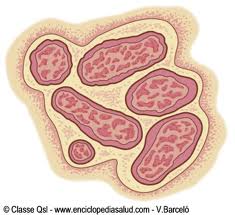it is produced by Brucella melitensis or by Brucella avis; two bacteria other than B. ovis infection affects only the cattle sheep in producing a box labeled: infectious epididymitis epididymitis of sheep or lambs. There is no evidence of contagion to the human species .

Symptoms
- Repetition of jealousy in served sheep .
- Lower calving and weaning percentage. .
- High perinatal mortality.
- Term abortions.
- Birth of weak lambs.
Clinical manifestation
Brucellosis causes lesions in the male genitalia producing infertility or subfertility. The most important clinical manifestations in rams are epididymitis and decreased fertility, due to the poor quality of the semen , forcing re-producers of high genetic value to be eliminated; it also produces abortion in ewes and the births of weak lambs. In most cases, lesions on the testes and epididymis can only be detected by palpation. A thickening and hardening can be detected especially of the head and body of the epididymis.
Diagnosis of the disease
- Clinically examining rams by testicular and node palpation .
- Extracting semen and blood to send to the laboratory for analysis.
Clinical diagnosis
The palpation of the testes and the presence of epididymitis, although important, can only give us an indication of the magnitude of the disease in the herd, since not all infected rams present lesions and there are other causes that can also cause epididymitis .
Bacteriological diagnosis
Isolation of B. avis from semen enables conclusive diagnosis. However, not all infected rams always shed germs in their ejaculate. If the causative agent can be isolated from a biological sample, it is irrefutable proof that the animal is infected.
Serological diagnosis
This methodology consists of detecting antibodies in blood against the bacterium B. avis, separating and analyzing the serum of the animals under study. They are techniques used for their speed, economy and practicality. The tests detect the presence of antibodies , the ones currently recommended for B. avis are:
- Complement Fixation (FC);
- ELISA and Immunodiffusion on agar gel.
Elimination routes
In rams , it is eliminated in semen and in some cases in urine . In infected sheep, the bacteria are eliminated vaginally, for several weeks after delivery or abortion, through the placenta , discharge of fluids , blood , aborted fetus . The infection of the breasts produces active excretion in milk that can last several successive lactations. The offspring of infected ewes could be born infected or infected by suckling colostrum or mother’s milk with Brucellosis.
Prevention and control
- Not admitting animals without previous examination; require a certificate of free Brucellosis from the seller’s advising veterinarian.
- Checking all the rams 2 times a year . As a routine a check 60 days before the service; It is necessary and essential to identify the animals individually , through a safe and permanent system.
- Eliminating animals with problems, to avoid contagion from sheep , sheep and other rams . It is important to clarify that castration does not prevent these animals from continuing to be infected. The positives must be immediately separated from the rest and, if possible, immediately sent to work.
- Change the management of the males, keeping the new rams, separated from the older adults.
- If possible, serve ewes with young lambs, even if they have less sexual experience, but good weight and body condition.
- Applying a preventive health program, with an adequate health calendar, and a health and production registration system. These measures are part of the program of good sanitary management practices.
